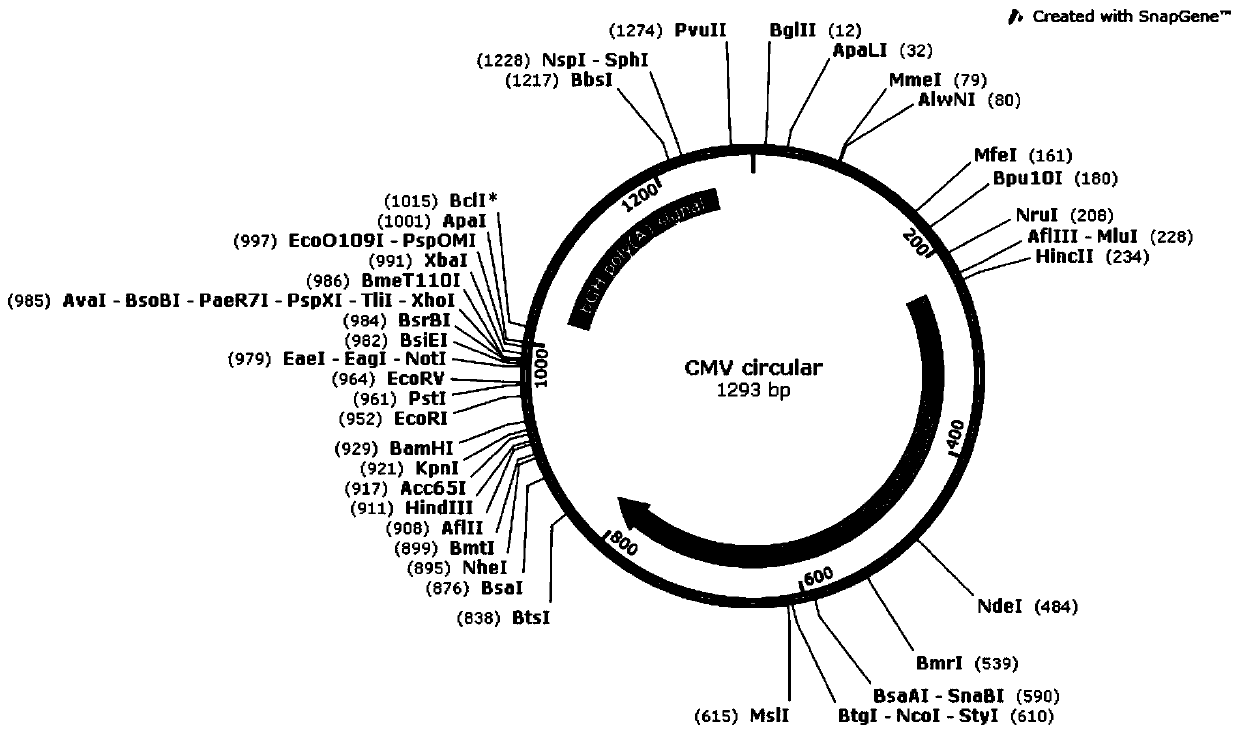Transfection agent for in-vivo gene expression protein system, and in-vitro transfection method of transfection agent
A technology for gene expression and expression system, which is applied to the transfection agent of gene expression protein system in vivo and the field of in vitro transfection, can solve the problems of few positive charges, poor transfection efficiency, low transfection efficiency, etc., and achieves toxicity. Small, reduced work links, high efficiency
- Summary
- Abstract
- Description
- Claims
- Application Information
AI Technical Summary
Problems solved by technology
Method used
Image
Examples
preparation example Construction
[0041] Wherein the preparation method of the plasmid having the protein gene sequence to be expressed comprises the following steps:
[0042] Step 1, construct gene carrier, such as figure 1 The vector shown is based on a circular plasmid vector. The sequence of the circular plasmid vector is shown in Sequence Table 1. The CMV (CMV enhancer+CMV promoter) in the circular plasmid is used as the promoter, containing Poly(A), circular The sequence of the plasmid vector is shown in Sequence Table 1, and the total length is 1293bp;
[0043] Step 2, insert the protein gene sequence to be expressed between the CMV promoter and the Poly(A) on the gene vector constructed in the step 1, taking the insertion of a fluorescent protein gene fragment as an example, its structure is as follows figure 2 As shown, the gene sequence is shown in sequence 2.
[0044] The preparation method of the chitosan polylysine polymer for the transfection agent of gene expression protein system in vivo as ...
Embodiment 1
[0050] 1. In vitro transfection, taking 293T cells as an example:
[0051] In the first step, transfection was carried out in a 6-well cell culture plate, and the cells were divided into 5X10 5 Inoculate the cells / well, add 2-5ml complete medium (medium + 10% serum), and culture overnight;
[0052] In the second step, take 5 μg of fluorescent plasmid / well, mix it with chitosan polylysine polymer at a volume ratio of 1:3, and mix well;
[0053] In the third step, add 100 μl of OMEM medium and mix thoroughly;
[0054] In the fourth step, add 20 μl of 50% PEG3350 and mix well;
[0055] In the fifth step, the mixture is added to the cell culture system of the six-well plate;
[0056] The sixth step, replace the culture medium after 24 hours;
[0057] The seventh step is to continue to observe for 48 hours.
[0058] like Figure 4 As shown, after 293T cells were transfected, observed after 24 hours, the cell expression fluorescence efficiency was about 30%, as shown in Figu...
Embodiment 2
[0066] 1. In vitro transfection, taking 293T cells as an example:
[0067] In the first step, transfection was carried out in a 6-well cell culture plate, and the cells were divided into 5X10 5 Inoculate the cells / well, add 2-5ml complete medium (medium + 10% serum), and culture overnight;
[0068] In the second step, take 5 μg of fluorescent plasmid / well, mix it with chitosan polylysine polymer at a volume ratio of 1:3, and mix well;
[0069] In the third step, add 100 μl of OMEM medium and mix thoroughly;
[0070] In the fourth step, add 20 μl of DMSO and mix well;
[0071] In the fifth step, the mixture is added to the cell culture system of the six-well plate;
[0072] The sixth step, replace the culture medium after 24 hours;
[0073] The seventh step is to continue to observe for 48 hours.
[0074] like Figure 7 As shown, after 293T cells were transfected, observed after 24 hours, the cell expression fluorescence efficiency was about 30%, as shown in Figure 8 As...
PUM
 Login to View More
Login to View More Abstract
Description
Claims
Application Information
 Login to View More
Login to View More - R&D
- Intellectual Property
- Life Sciences
- Materials
- Tech Scout
- Unparalleled Data Quality
- Higher Quality Content
- 60% Fewer Hallucinations
Browse by: Latest US Patents, China's latest patents, Technical Efficacy Thesaurus, Application Domain, Technology Topic, Popular Technical Reports.
© 2025 PatSnap. All rights reserved.Legal|Privacy policy|Modern Slavery Act Transparency Statement|Sitemap|About US| Contact US: help@patsnap.com



